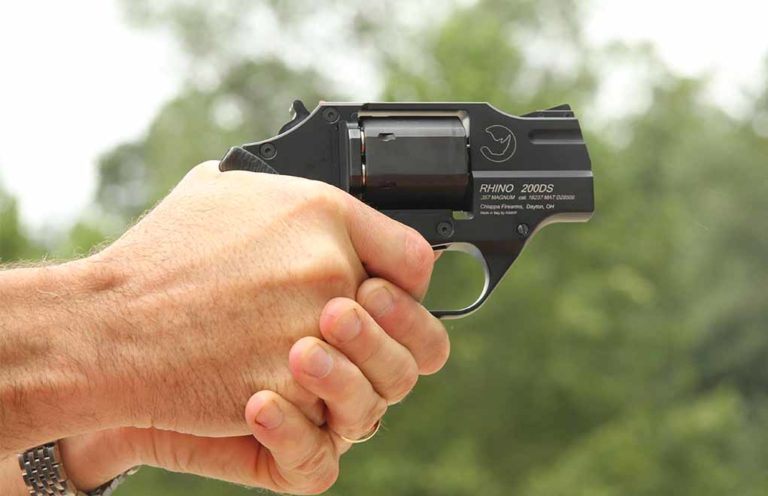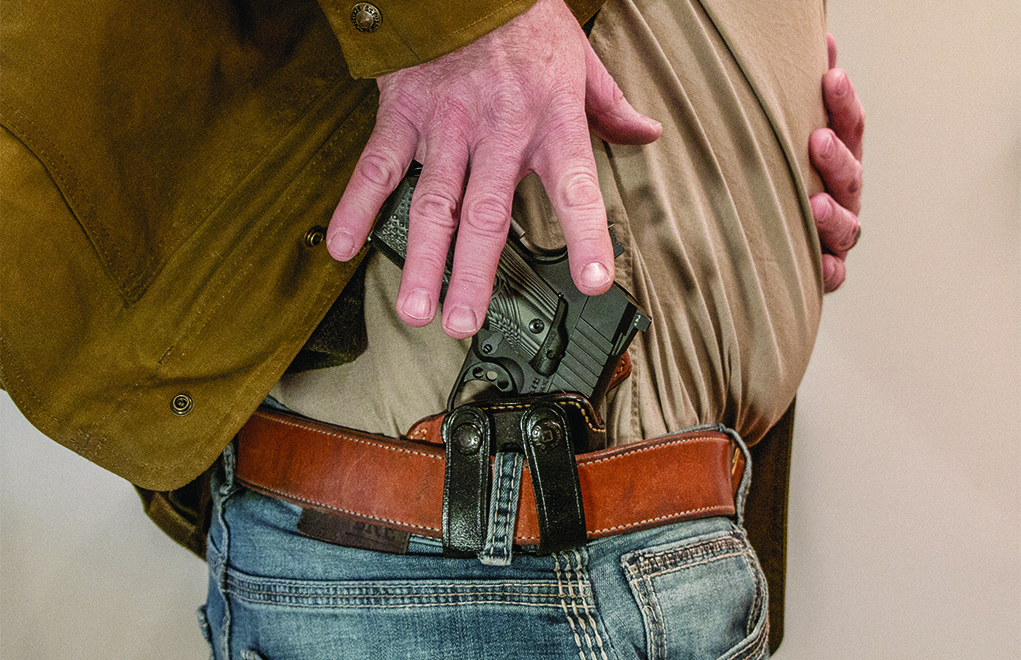
When is it brandishing and when is it a legal display of a firearm to back down an attack?
On June 28, 2020, in response to a riotous mob breaking through an iron gate into their St. Louis gated community, with a mass of approximately 300 people coming down the road toward their house, attorneys Mark and Patricia McCloskey grabbed firearms, he an AR-15 and she, a Bryco 9mm. They went outside their home to confront the riotous mob from their front porch. In doing so, they set themselves up for St. Louis Circuit Attorney Kim Gardner to charge them with “Unlawful Use of a Weapon.”

The legal case against the McCloskeys will take many months to resolve, and until the trial occurs, we won’t see all the evidence of the case, although YouTube videos featuring Mark McCloskey indicate that he had a fear of being attacked by the mob, which is why he used the AR-15 the way he did.
So, with this case in mind, let’s discuss the right to threaten deadly force with the use of a weapon against those who are threatening you. This analysis isn’t state-specific, but instead is intended to be considered general education. It’s up to the individual armed citizen to know what his or her state’s statutory and case laws show.
Know Your Rights:
- Carry Law: What Is A Righteous Shooting?
- Concealed Carry and the Right to Remain Silent
- Tips For Communicating With Police After Shootings
- Concealed Carry: After the Shooting
- Q&A: Massad Ayoob On Self-Defense In 2020 America
Brandishing
The common law of the United States ordinarily calls a criminal charge of waving a gun around in public “brandishing.” In many other states, it’s illegal to “unlawfully display” a firearm or “unlawfully exhibiting” a firearm.
Additionally, most if not all states have statutes that make it an “assault” to point or aim a weapon at someone without the justification of self-defense. And, since a firearm is used, the seriousness of that particular charge (called “aggravated assault” in states that follow the common law) elevates it to a serious felony with possible sentencing entailing years of jail time. A firearms enhancement means probably five years or more in prison.
So, when is having a gun “at the ready,” meaning in-hand and observable, not a crime? To determine that, you need to look at both your own statutory law and the case law interpreting the statutory law. Generally speaking, though, if you display a firearm (but not point it) in the face of presently threatened unlawful force, you’re likely to be in good shape.
I’d be surprised to find any state that doesn’t allow you to back down a criminal attacker by displaying a firearm and calmly telling him to stop doing what he’s doing or contemplating doing. This would apply only if the aggressor was threatening your safety. The amount of force you can use depends entirely on how much force is threatened against you.

If a person or persons are threatening to kill/rape/rob you, and they have the means to accomplish the threat, you’re likely going to be legally justified in pointing a gun at the aggressor(s). But, on the other hand, if someone who doesn’t obviously possess the means to carry out the threat, you had best keep your gun unseen. If there isn’t such an immediate threat, why not walk away? If doing so wouldn’t escalate the peril you’re in, then avoiding the entanglement would be the best bet.
Gray Areas
What about the gray areas, though? What about the times when you might not know what the situation really is, but you have a pretty firm belief that things are going to escalate quickly to endanger your life?
That’s when you need to invoke the reasonable person doctrine. What would a reasonable and prudent person believe, knowing what you know, and seeing what you see? Simpler put, how would this look to others?
One thing you don’t want to do when displaying a firearm or other dangerous weapon in the face of presently threatened unlawful force is make threats to kill. A new crime, which has popped up and is a favorite of prosecutors looking to be able to arrest gun owners, is the crime of “making terrorist threats.” The threat to kill, coupled with the ability to carry out the threat, fulfills the elements of this crime. Typically, the crime is a felony, with the result of conviction bringing jail or prison time, along with loss of your firearm rights. Don’t make threats to kill or even threaten to shoot.
Right about now, you might be thinking this advice seems very complicated. You may think, heck, you have trouble enough just hit the target, let alone issue verbal commands. If so, seek out competent training, which usually isn’t cheap, but well worth it when you actually have to draw that new blaster.
If this isn’t possible, may I suggest pepper spray?
Editor's Note: This article originally appeared in the January 2021 issue of Gun Digest the Magazine.

Next Step: Get your FREE Printable Target Pack
Enhance your shooting precision with our 62 MOA Targets, perfect for rifles and handguns. Crafted in collaboration with Storm Tactical for accuracy and versatility.
Subscribe to the Gun Digest email newsletter and get your downloadable target pack sent straight to your inbox. Stay updated with the latest firearms info in the industry.

![Best Concealed Carry Guns In 2025 [Field Tested] Wilson Combat EDC X9S 1](https://gundigest.com/wp-content/uploads/Wilson-Combat-EDC-X9S-1-324x160.jpg)


![Best 9mm Carbine: Affordable PCCs [Tested] Ruger Carbine Shooting](https://gundigest.com/wp-content/uploads/Ruger-Carbine-Shooting-100x70.jpg)
![Best AR-15: Top Options Available Today [Field Tested] Harrington and Richardson PSA XM177E2 feature](https://gundigest.com/wp-content/uploads/Harrington-and-Richardson-PSA-XM177E2-feature-100x70.jpg)

What if you do everything right & the police are called? What if the initial ‘aggressor’ lies & said you threatened to shoot or kill them? Dirtbags tend to lie. I am also a member of ACLDN for close to 10 years. Smartest thing I ever did. Great support. Great experts on the committee.
They were on there own property there is no grey area. They both got screwed by A POS DA and judge..